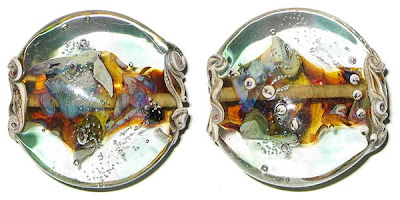1 - Plain, 2 - Reduced, 3 - w/ Silver foil, 4 - w/ Silver foil - reduced & encased, 5 - w/ Triton, 6 - w/ Striking Color frit, 7 - w/ Black, 8 - w/ Ivory, 9 - w/ Copper Green
Colour Range
Depending on what it's with and how much it's struck, CiM Tamarind Unique #1 seems to range from a slightly greyish tan (Bead #8) to a rich, chocolate brown (Bead #5, Bead #6). Making a spacer with a minimum of fuss, shaping or striking resulted in a creamy caramel colour. (Bead #1, Bead #2)
Reduction
Reducing Tamarind Unique alone (Bead #2) doesn't really seem to have any effect on the colour.
Reactions
 I used silver foil instead of silver leaf with the Tamarind Unique, and I had a kind of 'silver crust' form on the bead. (Bead #3, Bead #4) A lot of colours try to absorb silver, but Tamarind Unique isn't one of them. I'm not sure if this would be as evident with silver leaf, since there'd be less silver to form the crust, but I guess I'll have to try it now.
I used silver foil instead of silver leaf with the Tamarind Unique, and I had a kind of 'silver crust' form on the bead. (Bead #3, Bead #4) A lot of colours try to absorb silver, but Tamarind Unique isn't one of them. I'm not sure if this would be as evident with silver leaf, since there'd be less silver to form the crust, but I guess I'll have to try it now.Reducing and encasing the silver just turned a lot of the attractive crust that you can see in Bead #3 to black. (Bead #4)
 I'm having trouble deciding if the darkening of the colour is due to the silver or if it is entirely temperature-related. I don't think it is just the silver, because there's no silver on some of the half 'n half beads (Beads #7, #8 & #9) and a few of them struck to a darker colour as well. I guess a little more careful experimentation is required here.
I'm having trouble deciding if the darkening of the colour is due to the silver or if it is entirely temperature-related. I don't think it is just the silver, because there's no silver on some of the half 'n half beads (Beads #7, #8 & #9) and a few of them struck to a darker colour as well. I guess a little more careful experimentation is required here.Striking silver glass is ok on Tamarind Unique, but I don't really like how Triton blackened. (Beads #5 & #6) The blackening of the Triton is similar to all the black gunge that showed up when I reduced with silver on Bead #4.
Ivory on Tamarind Unique separates a little and develops a thin translucent line in stringerwork and a fine translucent dot in the middle of dots. (Bead #8) The Tamarind Unique on Ivory doesn't reciprocate that effect, which is interesting. Often, if one colour has that reaction, the other one will do something similar with it. The edges of the Tamarind Unique against the Ivory do look a little undistinct, as though they are bleeding into the Ivory a little.
The Tamarind Unique also looked a little more greyish in this bead than it did in the others. I'm not sure if that's related to the Ivory, or if it was a difference in how thoroughly it was struck, but the fact that the tonality is so different seems to indicate that it's due to the Ivory. I'll need to play with this a little to be sure.
The Tamarind Unique also looked a little more greyish in this bead than it did in the others. I'm not sure if that's related to the Ivory, or if it was a difference in how thoroughly it was struck, but the fact that the tonality is so different seems to indicate that it's due to the Ivory. I'll need to play with this a little to be sure.
I think out of all of these test beads, this one with Copper Green is my favourite. (Bead #9) The Tamarind Unique dots on top of Copper Green develop an outline that looks almost Teal, and the Copper Green on Tamarind spreads a little and develops a soft brown line that looks almost like a shadow. The reaction is subtle, but I think its really attractive.
General Impressions
I really love the colour of Tamarind Unique, and wish there was going to be more of it - and I wouldn't honestly care if more of it came out exactly like this batch or if it was really different and I had do do my tests again. Browns are something we don't have enough of and this is a particularly cool one.
I have been using this colour a lot as a way of end-capping my beads because the colour complements a lot of silver glass colours and reactions between colours really well.
Here are some other beads made with Tamarind Unique:



















































